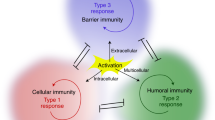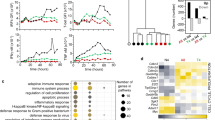Abstract
We evaluated changes in the signaling potentials and proliferative capacity of single antigen–specific T helper (TH) cells during a primary immune response to a protein antigen. At the peak of cellular expansion in vivo all antigen-specific TH cells exhibited a profound block in CD3- and CD4-mediated mobilization of intracellular calcium together with a more global block in T cell receptor–independent capacitative calcium entry (CCE). The proliferative response of these antigen-specific TH cells to anti-CD3, anti-CD28 and IL-2 was also severely blunted. Cross-linking CD69 on a substantial fraction of CD69+ antigen–specific TH cells relieved this block in CCE and restored proliferative capacity in vitro. The CCE rescue operated through a CD69-coupled G protein and required calcium-bound calmodulin and calcineurin. These data reveal critical changes in the responsiveness of antigen-specific TH cells and provide evidence of new mechanisms for the regulation of antigen-specific TH cell development in vivo.
This is a preview of subscription content, access via your institution
Access options
Subscribe to this journal
Receive 12 print issues and online access
$209.00 per year
only $17.42 per issue
Buy this article
- Purchase on Springer Link
- Instant access to full article PDF
Prices may be subject to local taxes which are calculated during checkout









Similar content being viewed by others
References
Davis, M. M. et al. Ligand recognition by αβ T cell receptors. Annu. Rev. Immunol. 16, 201–223 (1998).
Kearney, E. R., Pape, K. A., Loh, D. Y. & Jenkins, M. K. Visualization of peptide-specific T cell immunity and peripheral tolerance induction in vivo. Immunity 1, 327 –339 (1994).
McHeyzer-Williams, M. G. & Davis, M. M. Antigen-specific development of primary and memory T cells in vivo. Science 268, 106–111 ( 1995).
Grakoui, A. et al. The immunological synapse: a molecular machine controlling T cell activation. Science 285, 221– 227 (1999).
Gulbranson-Judge, A. & MacLennan, I. C. M. Sequential antigen-specific growth of T cells in the T zones and follicles in response to pigeon cytochrome c. Eur. J. Immunol. 26, 1830–1837 (1996).
Zheng, B., Han, S., Zhu, Q., Goldsby, R. & Kelsoe, G. Alternative pathways for the selection of antigen-specific peripheral T cells. Nature 384, 263–266 (1996).
Garside, P. et al. Visualization of specific B and T lymphocyte interactions in the lymph node. Science 281, 96– 99 (1998).
McHeyzer-Williams, L. J., Panus, J. F., Mikszta, J. A. & McHeyzer-Williams, M. G. Evolution of antigen-specific T cell receptors in vivo: preimmune and antigen-driven selection of preferred complementarity-determining region 3 (CDR3) motifs. J. Exp. Med. 189, 1823–1838 (1999).
Ahmed, R. & Gray, D. Immunological memory and protective immunity: understanding their relation. Science 272, 54–60 (1996).
Dutton, R. W., Bradley, L. M. & Swain, S. L. T cell memory. Annu. Rev. Immunol. 16, 201–223 ( 1998).
Schwartz, R. H. T-lymphocyte recognition of antigen in association with gene products of the major histocompatibility complex. Annu. Rev. Immunol. 3, 237–261 (1985).
Jorgensen, J. L., Esser, U., Fazekas de St. Groth, B., Reay, P. A. & Davis, M. M. Mapping T-cell receptor-peptide contacts by variant peptide immunization of single-chain transgenics. Nature 355, 224– 230 (1992).
Savage, P. A., Boniface, J. J. & Davis, M. M. A kinetic basis for T cell receptor repertoire selection during an immune response. Immunity 10, 485–492 (1999).
Swain, S. L., Hu, H. & Huston, G. Class II-independent generation of CD4 memory T cells from effectors. Science 286, 1381–1383 ( 1999).
Tsien, R. Y., Pozzan, T. & Rink, T. J. T-cell mitogens cause early changes in cytoplasmic free Ca2+ and membrane potential in lymphocytes. Nature 295, 68–71 ( 1982).
Weiss, A., Imboden, J., Shoback, D. & Stobo, J. Role of T3 surface molecules in human T-cell activation: T3-dependent activation results in an increase in cytoplasmic free calcium. Proc. Natl Acad. Sci. USA 81, 4169–4173 (1984).
Crabtree, G. R. Contingent genetic regulatory events in T lymphocyte activation. Science 243, 355–361 ( 1989).
Timmerman, L. A., Clipstone, N. A., Ho, S. N., Northrop, J. P. & Crabtree, G. R. Rapid shuttling of NF-AT in discrimination of Ca2+ signals and immunosuppression . Nature 383, 837–840 (1996).
Iwashima, M., Irving, B. A., van Oers, N. S., Chan, A. C. & Weiss, A. Sequential interactions of the TCR with two distinct cytoplasmic tyrosine kinases. Science 263, 1136–1139 ( 1994).
Emmel, E. A. et al. Cyclosporin A specifically inhibits function of nuclear proteins involved in T cell activation. Science 246, 1617–1620 (1989).
Lenschow, D. J., Walunas, T. L. & Bluestone, J. A. CD28/B7 system of T cell costimulation . Annu. Rev. Immunol. 14, 233– 258 (1996).
Harding, F. A., McArthur, J. G., Gross, J. A., Raulet, D. H. & Allison, J. P. CD28-mediated signalling co-stimulates murine T cells and prevents induction of anergy in T-cell clones. Nature 356, 607– 609 (1992).
Mikszta, J. A., McHeyzer-Williams, L. J. & McHeyzer-Williams, M. G. Antigen-Driven Selection of TCR In Vivo: Related TCR α-Chains Pair with Diverse TCR β-Chains . J. Immunol. 163, 5978– 5988 (1999).
Boniface, J. J. et al. Initiation of signal transduction through the T cell receptor requires the multivalent engagement of peptide/MHC ligands. Immunity 9, 459–466 ( 1998).
Maraskovsky, E., Pech, M. H. & Kelso, A. High-frequency activation of single CD4+ and CD8+ T cells to proliferate and secrete cytokines using anti-receptor antibodies and IL-2. Int. Immunol. 3, 255–264 (1991).
Hodgkin, P. D., Lee, J. H. & Lyons, A. B. B cell differentiation and isotype switching is related to division cycle number. J. Exp. Med. 184 , 277–281 (1996).
Berridge, M. J. Capacitative calcium entry. Biochem. J. 312, 1–11 (1995).
Putney, J. W., Jr TRP, inositol 1,4,5-trisphosphate receptors, and capacitative calcium entry. Proc. Natl Acad. Sci. USA 96, 14669–14671 (1999).
Lewis, R. S. Store-operated calcium channels. Adv. Second Messenger Phosphoprotein Res. 33, 279–307 ( 1999).
Risso, A. et al. CD69 in resting and activated T lymphocytes. Its association with a GTP binding protein and biochemical requirements for its expression . J. Immunol. 146, 4105– 4114 (1991).
Vertessy, B. G. et al. Simultaneous binding of drugs with different chemical structures to Ca2+-calmodulin: crystallographic and spectroscopic studies . Biochemistry 37, 15300– 15310 (1998).
Zhang, W., Sloan-Lancaster, J., Kitchen, J., Trible, R. P. & Samelson, L. E. LAT: the ZAP-70 tyrosine kinase substrate that links T cell receptor to cellular activation . Cell 92, 83–92 (1998).
Zhang, W., Irvin, B. J., Trible, R. P., Abraham, R. T. & Samelson, L. E. Functional analysis of LAT in TCR-mediated signaling pathways using a LAT-deficient Jurkat cell line. Int. Immunol. 11, 943– 950 (1999).
Krummel, M. F. & Allison, J. P. CTLA-4 engagement inhibits IL-2 accumulation and cell cycle progression upon activation of resting T cells. J. Exp. Med. 183, 2533– 2540 (1996).
Waterhouse, P. et al. Lymphoproliferative disorders with early lethality in mice deficient in Ctla-4. Science 270, 985–988 (1995).
Marengere, L. E. et al. Regulation of T cell receptor signaling by tyrosine phosphatase SYP association with CTLA-4. Science 272, 1170–1173 (1996).
Plas, D. R. et al. Direct regulation of ZAP-70 by SHP-1 in T cell antigen receptor signaling. Science 272, 1173– 1176 (1996).
Ono, M., Bolland, S., Tempst, P. & Ravetch, J. V. Role of the inositol phosphatase SHIP in negative regulation of the immune system by the receptor Fc(γ)RIIB. Nature 383, 263 –266 (1996).
Philosophe, B. & Miller, R. A. T lymphocyte heterogeneity in old and young mice: functional defects in T cells selected for poor calcium signal generation. Eur. J. Immunol. 19, 695–699 (1989).
Fanger, C. M., Hoth, M., Crabtree, G. R. & Lewis, R. S. Characterization of T cell mutants with defects in capacitative calcium entry: genetic evidence for the physiological roles of CRAC channels. J. Cell Biol. 131, 655–667 (1995).
Serafini, A. T. et al. Isolation of mutant T lymphocytes with defects in capacitative calcium entry. Immunity 3, 239– 250 (1995).
Liu, K. Q., Bunnell, S. C., Gurniak, C. B., Berg, L. J. T cell receptor-initiated calcium release is uncoupled from capacitative calcium entry in Itk-deficient T cells. J. Exp. Med. 187, 1721–1727 (1998)
Schwartz, R. H. T cell clonal anergy. Curr. Opin. Immunol. 9, 351–357 (1997).
Ramsdell, F. & Fowlkes, B. J. Maintenance of in vivo tolerance by persistence of antigen. Science 257, 1130–1134 (1992).
Rocha, B., Tanchot, C. & Von Boehmer, H. Clonal anergy blocks in vivo growth of mature T cells and can be reversed in the absence of antigen. J. Exp. Med. 177, 1517–1521 ( 1993).
Ansel, K. M., McHeyzer-Williams, L. J., Ngo, V. N., McHeyzer-Williams, M. G. & Cyster, J. G. In vivo -activated CD4 T cells upregulate CXC chemokine receptor 5 and reprogram their response to lymphoid chemokines. J. Exp. Med. 190, 1123–1134 (1999).
Panus, J. F., McHeyzer-Williams, L. J. & McHeyzer-Williams, M. G. Antigen-Specific Th cell function: Differential cytokine expression in primary and memory responses. J. Exp. Med. (in the press, 2000).
Lauzurica, P. et al. Phenotypic and functional characteristics of hematopoietic cell lineages in CD69-deficient mice. Blood 95, 2312–2320 (2000).
McHeyzer-Williams, L. J., Cool, M. & McHeyzer-Williams, M. G. Antigen-specific B cell memory: expression and replenishment of a novel B220- memory B cell compartment. J. Exp. Med. 191, 1149–1166 (2000).
Driver, D. J., McHeyzer-Williams, L. J., Cool, M., Stetson, D. B. & McHeyzer-Williams, M. G. Development and maintenance of a B220− memory B cell compartment. J. Immunol. (submitted, 2000 ).
Haverstick, D. M., Densmore, J. J. & Gray, L. S. Calmodulin regulation of Ca2+ entry in Jurkat T cells. Cell Calcium 23 , 361–367 (1998).
Lee, A. et al. Ca2+/calmodulin binds to and modulates P/Q-type calcium channels. Nature 399, 155– 159 (1999).
Zuhlke, R. D., Pitt, G. S., Deisseroth, K., Tsien, R. W. & Reuter, H. Calmodulin supports both inactivation and facilitation of L-type calcium channels. Nature 399, 159–162 ( 1999).
Ma, H. -T. et al. Requirement of the inositol trisphosphate receptor for activation of store-operated Ca2+ channels. Science 287, 1647–1651 (2000).
Missiaen, L. et al. The bell-shaped Ca2+ dependence of the inositol 1,4, 5-trisphosphate- induced Ca2+ release is modulated by Ca2+/calmodulin. J. Biol. Chem. 274, 13748–13751 (1999).
Estacion, M., Sinkins, W. G. & Schilling, W. P. Stimulation of Drosophila TrpL by capacitative Ca2+ entry. Biochem. J. 341, 41– 49 (1999).
Acknowledgements
We thank D. Driver, J. Fanelli Panus, J. Mikszta, A. Means, T. Meyer, T. Tedder and M. Krangel for comments on the manuscript; M. Davis and J. Altman for the gift of MCC–I-Ek tetramers; D. Patel (core facility of the Duke Specialized Center of Research in RA) and J. P. Allison for gifts of anti-CD28 and anti-CD3; E. Shevach for the H1.2F3 hybridoma; and the Duke Comprehensive Cancer Center Flow Cytometry Shared Resource and Confocal Microscopy Facility. Supported by a National Institutes of Health grant (AI40215), a post-doctoral fellowship (RRPC) and a Biomedical Sciences Grant (MMW) from the Arthritis Foundation.
Author information
Authors and Affiliations
Corresponding author
Rights and permissions
About this article
Cite this article
Bikah, G., Pogue-Caley, R., McHeyzer-Williams, L. et al. Regulating T helper cell immunity through antigen responsiveness and calcium entry. Nat Immunol 1, 402–412 (2000). https://doi.org/10.1038/80841
Received:
Accepted:
Issue Date:
DOI: https://doi.org/10.1038/80841
This article is cited by
-
CD69-oxLDL ligand engagement induces Programmed Cell Death 1 (PD-1) expression in human CD4 + T lymphocytes
Cellular and Molecular Life Sciences (2022)
-
The function of follicular helper T cells is regulated by the strength of T cell antigen receptor binding
Nature Immunology (2009)
-
Lymphoid reservoirs of antigen-specific memory T helper cells
Nature Immunology (2007)
-
CD69 acts downstream of interferon-α/β to inhibit S1P1 and lymphocyte egress from lymphoid organs
Nature (2006)
-
Effector and memory T-cell differentiation: implications for vaccine development
Nature Reviews Immunology (2002)



